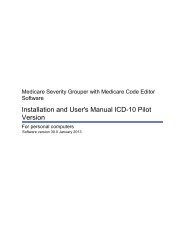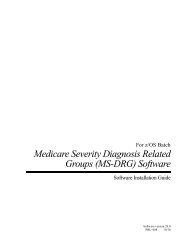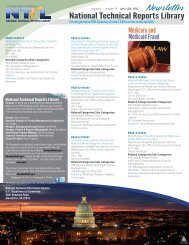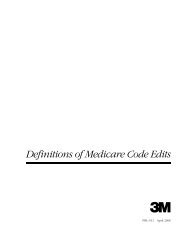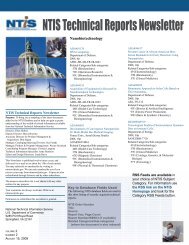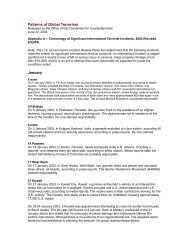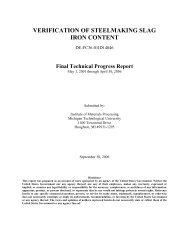DATABASE GUIDE - National Technical Information Service
DATABASE GUIDE - National Technical Information Service
DATABASE GUIDE - National Technical Information Service
You also want an ePaper? Increase the reach of your titles
YUMPU automatically turns print PDFs into web optimized ePapers that Google loves.
NTIS Subject Categories - Alphabetical Listing with Scope Descriptions5441‐Manufacturing Technology410‐General*Includes mechanical elements; Pipes; Tubes; Levers; Cams;Springs; Clutches; Gears; Valves; Filters; Containers andpacking materials; Refrigeration systems and equipment; Industrialfurnaces and boilers; Heat exchangers; Heat pumps;Heat pipes; Energy management, economics, and financing;International issues.See also 94O and 97G.For engine components, use 81.For fuel tanks, use 81C.For cooling towers, use 97J.41A‐Computer Aided Design (CAD)Application of computer hardware and software (programs) toenhance the design, computations, simulation, analysisand modeling, presentations, graphics, drafting, data basecreation and human‐machine interface, associated with thecreation of engineering design specifications.See also 94A.41B‐Computer Aided Manufacturing (CAM)Application of computer hardware and software (programs) toenhance materials planning, processing and handling, tooling;Assembly; Quality and reliability control; Inspection;Tests; Scheduling and control; Facilities and equipmentmaintenance; Group technology applications; Inventorycontrol (raw material, in process and finished); Numericalcontrols and automation; The creation of Direct NumericalControl (DNC) and Computer Numerical Control (CNC)manufacturing cells and systems.See also 94A and 94G.41C‐Robotics/RobotsApplication of computer hardware and software, controls, sensors,electromechanical and hydro‐mechanical devices, tothe creation of robots and the application of robots to all facetsof manufacturing. Study of biological processes in orderto develop engineering systems; Pattern recognition systemsbased on biological models. Includes feature extraction;Image enhancement; Image restoration; Scene analysis;Character recognition.See also 95F and 62F.41D‐ProductivityProductivity of employees, management, and services; Improvingquality of worklife; Measurement of productivity efficiencyand effectiveness; Employee attitudes and motivation;Manpower utilization and performance improvement, jobsatisfaction, job security; Labor‐management, job redesign;Alternative work schedules; Incentive plans; Productivitybarriers including regulation, obsolete practices; Paperwork,and financing methods.See also 70G and 70D.41E‐Manufacturing, Planning, Processing &ControlFabrication, assembling, cleaning, and finishing; Industrial andmanufacturing processes (limited to in‐depth studies thatdirectly discuss specific processes); Materials forming andmachining; Heat treatment; Fabrication and manufacturing;Layout; Coating processes; Materials handling and control,including palletizing, conveying, warehousing, storing,containerization, and packaging; Time and motion studies;Scheduling; Production controls and programming; Modelingtechniques and program controls; Inventory management.See also 94A.For the beneficiation and processing of minerals, use 48A.For chemical engineering and processing, use 99B.For computer‐aided manufacturing, use 41B and 94G.For lasers used in manufacturing, use 41M.For processing and packaging of food, use 98H.For production of materials, use 71.41F‐JoiningBonding and joining including gluing, welding, soldering, brazing,and fastening; Joints and fasteners; Physical, mechanical,and structural properties of adhesives, sealants, glue,binders, seals, and gaskets.See also 94G, 940 General, and 71B.41G‐Quality Control & ReliabilityTolerance allocation; Maintainability requirements; Probabilityof satisfactory performance of components and equipment;Inspection methods; Reliability theory; Quality assurance;Nondestructive testing having industrial application;Ultrasonic, radiographic, hydrostatic, magnetic, and opticalnondestructive techniques and equipment; Nondestructivetesting of flaws, thickness, opacity, strength; Destructiveindustrial testing; Metrology.See also 94B, 94J, and 940 General.41H‐Plant Design & MaintenanceSite selection; Plant design; Maintenance Management; Scheduled,routine, and corrective maintenance; Security.See also 94C.41I‐Job EnvironmentIndustrial hygiene and occupational safety and health. See also57U, 68G, and 44G. Workplace layout and design; Humanfactors engineering; Includes Industrial psychology andIndustrial sociology; Worker interactions.See also 94D and 95D.Includes environmental engineering equipment related to industrialuse. See also 97J, 89B, and 94E.For mine safety, use 48A.For ordnance safety, use 79A.For nuclear radiation safety, use 77.For transportation safety, use 85D.41J‐Tooling, Machinery, & ToolsMachine subassemblies; Tools; Machinery including hoists, conveyors,and pumps; Design, production performance, andtesting of hydraulic and pneumatic systems, accumulators,actuators, compressors and distribution equipment; Fluidicand flueric devices; Ergonomics interaction of man andequipment in terms of subsystem and system performancerequirements and evaluation; Man‐machine systems andhuman factors engineering.See also 94F, 94I, 94D, and 95D.For hydraulic fluids, use 71K.41K‐Engineering MaterialsPerformance; Properties, fabrication and manufacturing methodsof ceramics, coatings and composite materials includingceramic coatings, ceramic fibers, corrosion resistantcoatings, reinforced plastics, graphite or carbon composites,laminates; Metal matrix composites, and fiber andparticulate composites.See also 71B, 71D, and 71F.54



